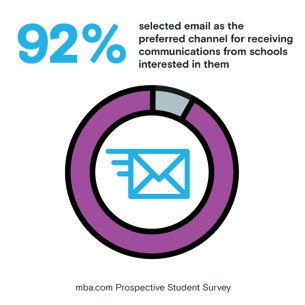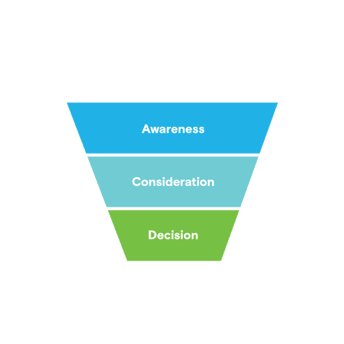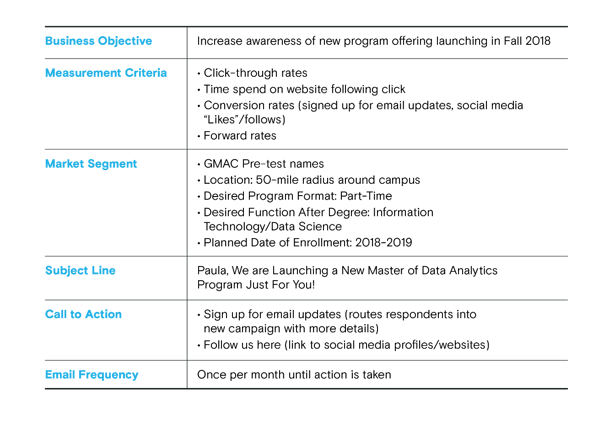Email marketing can be one of the most effective student recruitment tools for business schools. Learn how your team can use it to reach out to top candidates.

Today’s best business school candidates have a multitude of options to keep them connected. Push notifications, mobile texts, Twitter, Facebook, WeChat, WhatsApp, and the list goes on. Which method of communication however do candidates actually prefer? Good old-fashioned email.
GMAC surveyed over 1200 global prospective candidates in Q4 2019 and found that 92% of respondents chose email as their preferred method of communication for corresponding with institutions. Half of these candidates prefer to communicate by email only.

Here’s how you can use this channel to reach candidates more effectively.
Segmenting your student email marketing to reach the right candidates
The key to maximizing the value of email marketing for student recruitment is proper segmentation. By grouping candidates by location, professional experience, admissions stage, and other relevant parameters, you can ensure that your emails are more likely to pique their interest.
One of the most valuable tools you can use for this purpose is the GMASS search service. GMASS offers over 30 different categories of information and more than 2,000 possible unique search combinations, meaning you can pinpoint exactly the right audience for your campaigns. Our research has shown that segmented emails to b-school candidates result in nearly 14.3 percent higher open rates and 101 percent more clicks than one-size-fits-all campaigns.
Making email marketing campaigns for candidates at different stages of the enrollment journey
One of the most attractive things about email marketing is its versatility. B-schools can create tailored campaigns to nurture candidates at every stage of the enrollment journey. For those of you who are unfamiliar, the enrollment journey is typically divided into three stages: Awareness (when a prospective student wants to improve their professional circumstances but hasn't necessarily identified attending business school as the answer), Consideration (when a student is trying to decide on the right program and school for their needs), and Decision (when they are ready to enroll).
 This framework can help you deliver the right messages to the right candidates at the right time. For example, your school could use emails to increase brand awareness amongst a new target audience in the Awareness stage by directing them towards informative content on your website, like videos, infographics, or quizzes.
This framework can help you deliver the right messages to the right candidates at the right time. For example, your school could use emails to increase brand awareness amongst a new target audience in the Awareness stage by directing them towards informative content on your website, like videos, infographics, or quizzes.
As their interest grows, and they have reached the Consideration stage of their enrollment journey, you can encourage them to contact your admissions staff directly or to attend one of your events. Once they reach the Decision stage, your email campaigns can focus on driving them towards making an application by notifying them of deadlines and offering your assistance with applications, questions about requirements, financing, and more.
At every stage, the key to developing a coherent campaign is to define a clear objective, as well as measurable key performance indicators (KPIs) by which to evaluate your success. For an illustration of what this looks like in practice, let’s examine this sample campaign plan for promoting a new, part-time Master of Data Analytics program, which is targeted towards candidates in the Awareness Stage:

The school, in this case, has defined a single, clear goal: to increase awareness of its new program. Its target audience has also been segmented based on a number of highly relevant parameters to ensure the right candidates are reached. Perhaps most importantly, it has identified a number of clear indicators of success that it can track as the campaign progresses.
Aligning your content with your school’s campaign objectives
Too often, business schools can be guilty of a lack of focus in their email marketing efforts. This leads to content which, while it may have merit, fails to drive potential candidates towards taking clear, decisive action to further their educational ambitions.
Having properly defined, targeted campaigns will make it easier to align both your email content and any complementary content offers to your goals.
In the above example, the goal is to raise awareness of a new program, and the best way to do this is to provide recipients with interesting ways to learn more about it. Directing them to engaging website content like articles, infographics, and videos can be a winning approach in this situation.
You can also think outside the box a little. For instance, many marketers across different industries have found success with interactive and gamified content, like quizzes. In a Content Marketing Institute survey, 81 percent of respondents agreed that interactive content captured attention better than static content. This could make it an ideal tactic for business schools at this stage.
In addition, you should not underestimate the power of user-generated content. Articles, testimonials, and other contributions from your students, faculty, alumni, and even guest posts from industry leaders can add real weight to your email marketing efforts. This content also serves as valuable social proof of both the rewards of completing your programs and your school’s standing within the business world.
Automating email workflows for b-school campaigns
Once you have planned your campaign, identified how it should be segmented, and developed the right content, how do you tie it all together into an email strategy that will effectively connect with business school candidates?
One of the most effective ways to accomplish this is to create workflows that deliver a series of emails at carefully timed intervals. These should have a logical flow and order, and gradually nurture and build a prospect’s interest over a few weeks or months.
If your school uses marketing automation software, you can also build your workflows to be adaptive, and change the course of action with each recipient based on their response. For instance, if the goal of your workflow is to get candidates to sign up for one of your events, your workflow can automatically direct anyone who signs up into a separate branch where they will receive emails about what they need to know before attending. Those who have yet to sign up can be sent reminders to give them a final push.
Personalizing your mails for added value
Many people believe that mass email marketing campaigns can be a bit impersonal, as every recipient receives an identical, ‘stock’ message. However, there are plenty of tactics you can try to add a personal touch to your messages.
These can range from simple personalization tokens—such as adding a recipient’s name to the greeting or subject line of your mail—to more sophisticated personalization strategies which present different versions of your mail to different candidates depending on your segmentation criteria.
For instance, your school could use the GMASS search tool to personalize mails for candidates working in specific industries, including content that highlights how your programs are relevant to their specific sector.
Using email for recruitment events
Events are a crucial conversion touchpoint for many business schools. Through recruitment fairs like The MBA Tour, information sessions, meet-ups, and even online events like webinars, admissions teams have the chance to make a lasting impression on candidates and present their school’s unique selling points in a compelling way.
Student email marketing can play a pivotal role in this process, helping your school target highly qualified candidates for specific events, and follow up with them to solidify their interest in your school and programs.
Updating your student email marketing in the post-GDPR era
As many admissions professionals will know, compliance with The EU’s General Data Protection Regulations (GDPR) and other global privacy legislation has led to the need for greater vigilance when it comes to contacting potential business school candidates.
This legislation imposes strict rules on how organizations obtain consent from individuals to process and use their data online. It also requires them to make it as easy as possible for email recipients to unsubscribe and change their preferences. While stricter privacy laws are not a bad thing, it can make it harder for business schools to generate a steady stream of leads.
GMASS Connect’s lead generation services can be tremendously useful in helping you navigate this new reality. Your team can be sent a weekly list of candidates who have explicitly expressed interest in receiving communications from schools like yours, allowing you to build your contact lists while ensuring compliance with the new regulations.
Measuring your email marketing success
Your admissions and marketing staff will be able to access a wealth of data to help you gauge the performance of your email campaigns. You can monitor several key metrics to evaluate how well your strategy is working, such as:
- Open rates – The percentage of recipients who opened your email
- Click rates – The percentage of recipients who clicked on a link within your mail
- Bounces – The amount of mails that were not delivered to recipients due to invalid addresses, unsubscribes, etc.
- Unsubscribes – The number of recipients who opted out of receiving further contact form your school
As we saw in some of the examples outlined earlier in this blog, these metrics can serve as valuable KPIs at different stages in the enrollment journey. You can also use this data to identify improvements that you can make to your campaigns on an ongoing basis. A low open rate, for example, might indicate that the subject line of an email is not compelling enough.
Your admissions team can also use this data to identify highly engaged candidates and step up efforts to connect with them. Recipients who are reading your mails, clicking through on links to resources, and otherwise showing signs of serious interest can be prioritized over those that do not seem to be responding to what your school has to offer. The result will be a more measurable, actionable, and efficient recruitment process for your school.
Want to reach quality business school candidates? Talk to us about GMAC’s range of marketing and recruitment solutions including GMASS.
Webinar | How to Use Email Marketing More Effectively in Recruiting | [Access the Recording]
Related article: Wondering how you can attract your ideal candidate in a tough market? Check out How Schools Can Increase Their Graduate Business School Admissions During Economic Booms.
